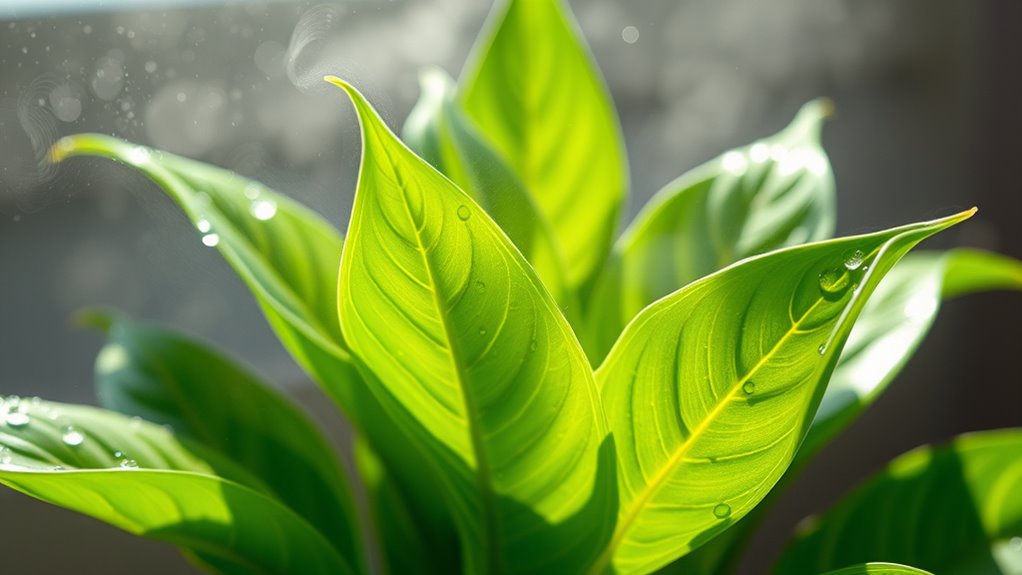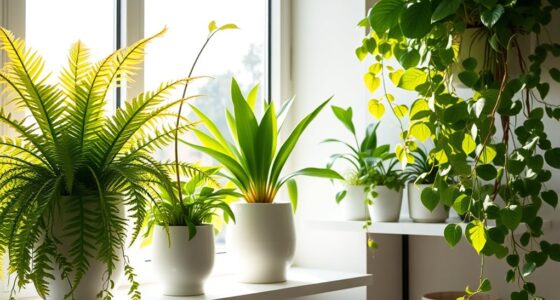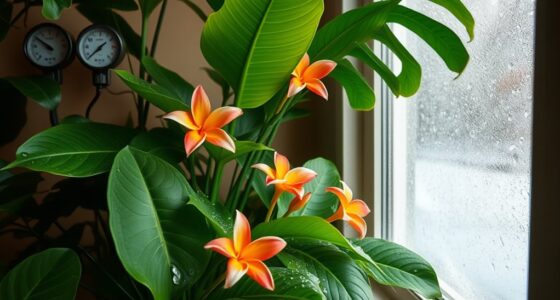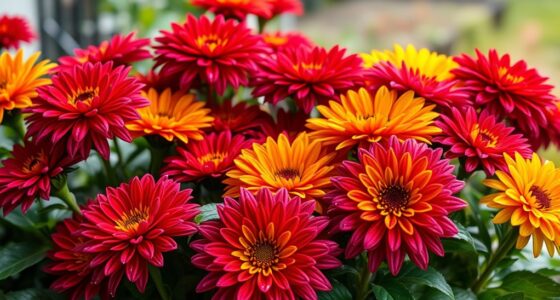Misting might seem like a quick fix to boost humidity and help your houseplants, but it’s often not very effective and can cause more problems. Spray water occasionally if needed, but don’t rely on it for long-term moisture or pest control. Over-misting can promote mold and attract pests, while other methods like pebble trays or humidifiers work better. Want to discover the full truth behind misting? Keep exploring for more plant care tips.
Key Takeaways
- Misting provides only temporary humidity boosts and is not a reliable long-term solution for houseplant care.
- Over-misting can promote mold, fungal growth, and pest issues, harming plants.
- Consistent humidity is better maintained with pebble trays or humidifiers rather than frequent misting.
- Misting is an auxiliary practice, not a substitute for proper watering and pest management.
- Relying solely on misting may cause dry air stress or mold; integrated methods ensure healthier plants.
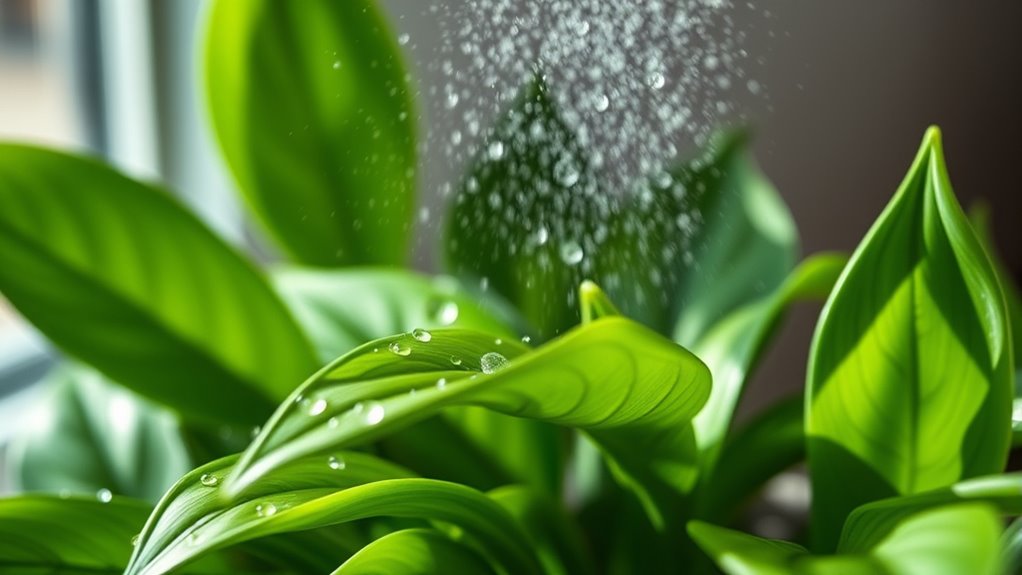
Have you ever believed that misting systems are a foolproof way to cool outdoor spaces? Many people think that spraying water into the air is an easy solution to reduce heat and create a more comfortable environment. While misting can indeed lower the temperature temporarily, it’s important to understand what it truly does and doesn’t do, especially when it comes to caring for your houseplants. Misting can influence humidity levels around your plants, but it’s not a definitive fix for all their needs. If you rely solely on misting for humidity control, you might overlook more effective methods that provide consistent moisture, like using a humidifier or grouping plants together. Over-misting can also lead to problems, such as promoting mold or fungal growth, which can harm your plants rather than help them thrive.
Furthermore, misting isn’t just about humidity; it also plays a role in pest prevention. Some pests, like spider mites and aphids, thrive in dry conditions, so increasing humidity through misting might seem like a good idea. However, if you’re not careful, you could end up creating a damp environment that attracts other problems, such as mold or bacterial infections. Instead of relying on misting to keep pests at bay, it’s better to focus on proper plant hygiene, regular inspection, and maintaining appropriate watering routines. Misting can temporarily wash away some pests or deter certain insects, but it’s not a holistic pest management strategy.
If you’re thinking about misting your houseplants, remember that it’s a supplementary practice rather than a primary solution. Many indoor plants, especially those originating from tropical regions, benefit from higher humidity levels, but they often require more consistent methods of humidity control. Using a pebble tray with water or a dedicated humidifier can provide a more stable environment. This not only helps your plants avoid stress caused by dry air but also reduces the risk of pest infestations that thrive in overly dry conditions.
In the end, misting can be part of your plant care routine, but it shouldn’t be the main approach. Relying on it solely for humidity control or pest prevention can lead to issues that might harm your plants more than help. By understanding what misting can and cannot do, you’ll be better equipped to create a healthy, pest-free environment for your houseplants. Focus on overall plant health, proper watering, and targeted pest control, and use misting as a gentle, occasional supplement rather than a cure-all.
Frequently Asked Questions
Can Misting Improve Humidity for All Types of Houseplants?
Misting can temporarily boost humidity levels for some plant species, but it doesn’t work equally for all. You might notice improvement with tropical plants that thrive in high humidity, but others, especially succulents or cacti, prefer dry conditions. To better support your houseplants, identify their specific humidity needs and use methods like humidifiers or grouping plants together, rather than relying solely on misting.
How Often Should I Mist My Houseplants for Optimal Health?
If you want to keep your peace lily healthy, mist it three times a week, but adjust based on its needs. For ideal plant hydration, stick to a consistent watering schedule and supplement with misting if your home is dry. For example, in winter, you might mist more often to compensate for heated indoor air. Always observe your plant’s response and avoid over-misting to prevent fungal issues.
Does Misting Prevent Pest Infestations on Houseplants?
Misting alone isn’t effective for pest prevention on houseplants. While it can temporarily increase humidity, pests like spider mites thrive in dry conditions, so misting may help deter them slightly, but it’s not a reliable method. To improve misting effectiveness, combine it with regular inspection and proper care. Focus on maintaining a healthy environment, proper watering, and cleaning leaves, rather than relying solely on misting for pest prevention.
Are There Risks Associated With Over-Misting Houseplants?
Sure, over-misting might seem harmless, but it actually increases your overwatering risk and promotes fungal growth. Ironically, what’s meant to hydrate your plants can drown their roots or cause mold to thrive. Too much water creates a damp environment, inviting pests and diseases. So, while misting feels like a gentle touch, it’s a fine line—too much can harm your houseplants more than help.
What Are Alternative Methods to Increase Humidity Besides Misting?
You can boost humidity for your houseplants by using humidity trays or placing water near your plants. Humidity trays, filled with pebbles and water, create a moist environment as the water evaporates. Alternatively, you might consider humidifier options, which effectively maintain consistent humidity levels without the risks of over-misting. Both methods help your plants thrive by increasing ambient moisture without the drawbacks of frequent spraying.
Conclusion
So, next time you consider misting your houseplants, remember that only about 10% of the water actually reaches the roots where it’s needed most. Instead of wasting time on misting, focus on proper watering and humidity levels. Your plants will thrive better with consistent care. Keep in mind, a humidifier can boost indoor moisture by up to 50%, creating a healthier environment. Don’t fall for the misting myth—your plants deserve real hydration!

